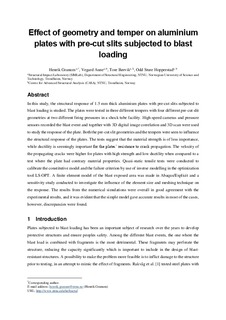| dc.contributor.author | Granum, Henrik | |
| dc.contributor.author | Aune, Vegard | |
| dc.contributor.author | Børvik, Tore | |
| dc.contributor.author | Hopperstad, Odd Sture | |
| dc.date.accessioned | 2019-11-13T13:31:04Z | |
| dc.date.available | 2019-11-13T13:31:04Z | |
| dc.date.created | 2019-08-20T13:05:52Z | |
| dc.date.issued | 2019 | |
| dc.identifier.issn | 0734-743X | |
| dc.identifier.uri | http://hdl.handle.net/11250/2628306 | |
| dc.description.abstract | This study investigates the structural response of blast-loaded aluminium plates with pre-cut slits. The 1.5 mm thick plates were tested after three different heat-treatments and with four different pre-cut slit geometries at two different blast intensities in a shock tube facility. By varying the number and orientations of the pre-cut slits, different crack patterns and failure modes were obtained in the plates, and it was found that the blast resistance of the plate was markedly affected by the design of the defects. The heat-treatments of the aluminium plates resulted in materials with different strength, work-hardening capacity and ductility, which made it possible to study the influence of these material characteristics on the structural behaviour. It was found that the heat-treatment affected the crack propagation and thus the blast resistance of the plates, whereas the failure mode was not significantly altered. High-speed cameras synchronised with pressure sensors recorded the blast event, and were together with 3D-DIC measurements and 3D-scans used to reveal the dynamic response of the plates. Quasi-static tensile tests were conducted to calibrate the parameters of the modified Johnson-Cook constitutive model and the Cockcroft–Latham failure criterion. Finite element models of the plates were made in Abaqus/Explicit and used in a sensitivity study to investigate the influence of element size and meshing technique on the predictions of crack propagation. Based on the sensitivity study, simulations of the blast experiments were performed using a randomly generated mesh of hexahedral solid elements with a characteristic element size of 0.5 mm. The finite element simulations were able to predict the initiation of failure correctly, even though the subsequent crack propagation was not accurately predicted in all cases. | nb_NO |
| dc.language.iso | eng | nb_NO |
| dc.publisher | Elsevier | nb_NO |
| dc.rights | Attribution-NonCommercial-NoDerivatives 4.0 Internasjonal | * |
| dc.rights.uri | http://creativecommons.org/licenses/by-nc-nd/4.0/deed.no | * |
| dc.title | Effect of heat-treatment on the structural response of blast-loaded aluminium plates with pre-cut slits | nb_NO |
| dc.type | Journal article | nb_NO |
| dc.type | Peer reviewed | nb_NO |
| dc.description.version | acceptedVersion | nb_NO |
| dc.source.volume | 132 | nb_NO |
| dc.source.journal | International Journal of Impact Engineering | nb_NO |
| dc.identifier.doi | 10.1016/j.ijimpeng.2019.05.020 | |
| dc.identifier.cristin | 1717379 | |
| dc.relation.project | Norges forskningsråd: 250553 | nb_NO |
| dc.description.localcode | © 2019. This is the authors’ accepted and refereed manuscript to the article. Locked until 20.5.2021 due to copyright restrictions. This manuscript version is made available under the CC-BY-NC-ND 4.0 license http://creativecommons.org/licenses/by-nc-nd/4.0/ | nb_NO |
| cristin.unitcode | 194,64,45,0 | |
| cristin.unitname | Institutt for konstruksjonsteknikk | |
| cristin.ispublished | true | |
| cristin.fulltext | postprint | |
| cristin.qualitycode | 2 | |

